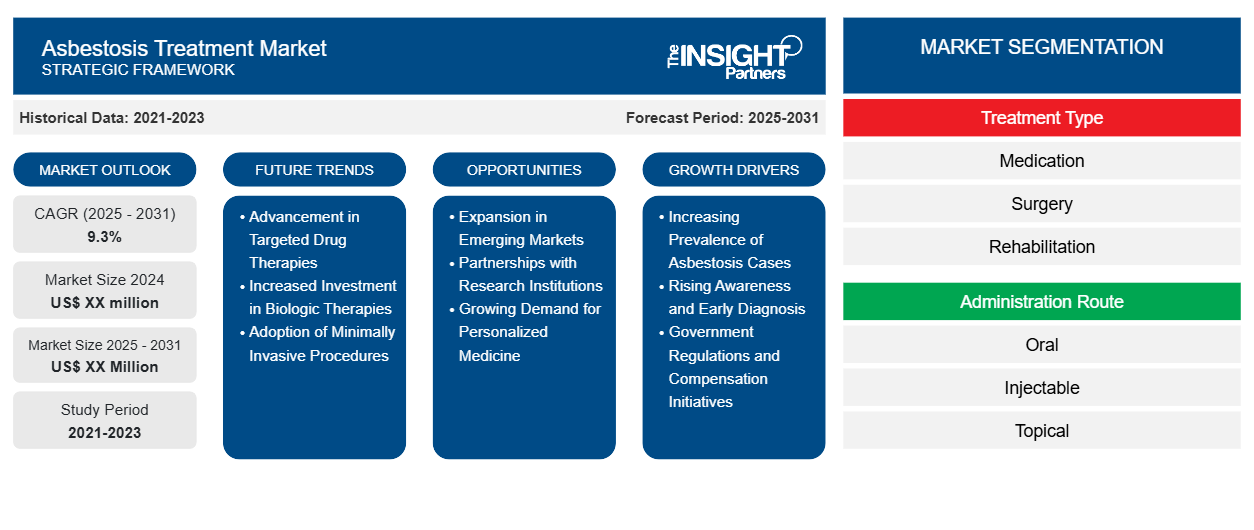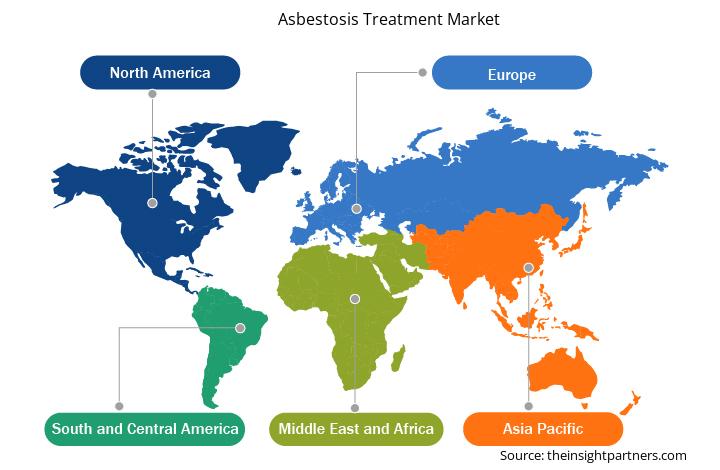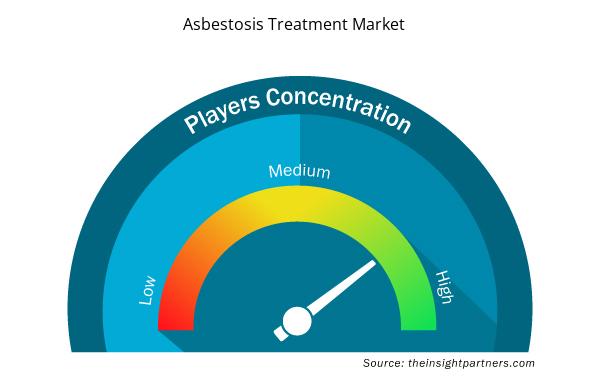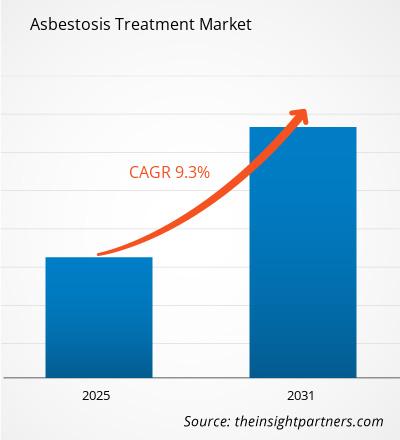The Asbestosis Treatment Market is expected to register a CAGR of 9.3% from 2025 to 2031, with a market size expanding from US$ XX million in 2024 to US$ XX Million by 2031.
The report is segmented by Treatment Type (Medication, Surgery, Rehabilitation, and Palliative Care), By Administration Route (Oral, Injectable, and Topical), By End user (Hospitals, Outpatient Clinics, and Specialized Treatment Centers)
Purpose of the Report
The report Asbestosis Treatment Market by The Insight Partners aims to describe the present landscape and future growth, top driving factors, challenges, and opportunities. This will provide insights to various business stakeholders, such as:
- Technology Providers/Manufacturers: To understand the evolving market dynamics and know the potential growth opportunities, enabling them to make informed strategic decisions.
- Investors: To conduct a comprehensive trend analysis regarding the market growth rate, market financial projections, and opportunities that exist across the value chain.
- Regulatory bodies: To regulate policies and police activities in the market with the aim of minimizing abuse, preserving investor trust and confidence, and upholding the integrity and stability of the market.
Asbestosis Treatment Market Segmentation
Treatment Type
- Medication
- Surgery
- Rehabilitation
- Palliative Care
Administration Route
- Oral
- Injectable
- Topical
End user
- Hospitals
- Outpatient Clinics
- Specialized Treatment Centers
Customize This Report To Suit Your Requirement
You will get customization on any report - free of charge - including parts of this report, or country-level analysis, Excel Data pack, as well as avail great offers and discounts for start-ups & universities
Asbestosis Treatment Market: Strategic Insights

- Get Top Key Market Trends of this report.This FREE sample will include data analysis, ranging from market trends to estimates and forecasts.
Asbestosis Treatment Market Growth Drivers
- Increasing Prevalence of Asbestosis Cases: The growing number of asbestosis cases, especially in industries such as construction, manufacturing, and shipbuilding, is driving the demand for effective treatments. As people with long-term asbestos exposure are diagnosed, the need for medical interventions to manage symptoms and improve quality of life is escalating, propelling market growth for asbestosis treatment.
- Rising Awareness and Early Diagnosis: Increased public awareness and improvements in diagnostic technologies have led to early detection of asbestosis. Early diagnosis enables more effective treatment, which has increased the demand for specialized medications, therapies, and interventions. This trend, coupled with healthcare advancements, has resulted in a more proactive approach to managing asbestosis, fueling the growth of the treatment market.
- Government Regulations and Compensation Initiatives: Governments are introducing stricter regulations to limit asbestos exposure and providing compensation for individuals suffering from asbestosis. These regulations are encouraging more people to seek treatment. Furthermore, insurance coverage and compensation for patients are motivating the treatment market's expansion, as people with asbestosis actively seek medical intervention to alleviate their symptoms and manage the disease.
Asbestosis Treatment Market Future Trends
- Advancement in Targeted Drug Therapies: Research and development in the pharmaceutical industry have led to the creation of targeted drug therapies for asbestosis. These treatments focus on addressing the underlying causes of lung scarring and inflammation, which has significantly improved patient outcomes. As a result, the market is shifting toward innovative therapies that specifically target the fibrosis and inflammation caused by asbestos exposure.
- Increased Investment in Biologic Therapies: The growing popularity of biologics, including monoclonal antibodies, has fueled the treatment market for asbestosis. Biologic therapies have shown promise in controlling inflammation and fibrosis, offering an alternative to traditional treatments like corticosteroids. The rising investment in biologics, due to their ability to target specific disease pathways, is reshaping the landscape of asbestosis management.
- Adoption of Minimally Invasive Procedures: There is an ongoing shift towards minimally invasive procedures for diagnosing and treating asbestosis, such as bronchoscopy and lung biopsy. These methods help in the early detection and monitoring of the disease with fewer complications. As patient preferences lean towards less invasive treatments, this trend is expected to drive growth in the asbestosis treatment market.
Asbestosis Treatment Market Opportunities
- Expansion in Emerging Markets: With rising industrialization in emerging economies, asbestosis cases are becoming more prevalent, creating a large untapped market for effective treatments. Healthcare infrastructure improvements and awareness campaigns in countries such as China, India, and Brazil provide significant opportunities for companies offering treatments for asbestosis to enter these markets and meet the increasing demand for healthcare solutions.
- Partnerships with Research Institutions: Pharmaceutical companies have opportunities to collaborate with research institutions and universities to conduct clinical trials and develop advanced treatments for asbestosis. These collaborations can lead to the discovery of more effective therapies and help companies stay ahead of market trends, positioning them as leaders in the competitive asbestosis treatment market.
- Growing Demand for Personalized Medicine: The increasing shift toward personalized medicine is creating opportunities for tailored asbestosis treatments. By focusing on genetic and environmental factors unique to each patient, pharmaceutical companies can develop more effective treatment protocols, potentially improving patient outcomes and boosting market growth. Personalized care is a key trend that can revolutionize the management of asbestosis.
Asbestosis Treatment Market Regional Insights
The regional trends and factors influencing the Asbestosis Treatment Market throughout the forecast period have been thoroughly explained by the analysts at Insight Partners. This section also discusses Asbestosis Treatment Market segments and geography across North America, Europe, Asia Pacific, Middle East and Africa, and South and Central America.

- Get the Regional Specific Data for Asbestosis Treatment Market
Asbestosis Treatment Market Report Scope
| Report Attribute | Details |
|---|---|
| Market size in 2024 | US$ XX million |
| Market Size by 2031 | US$ XX Million |
| Global CAGR (2025 - 2031) | 9.3% |
| Historical Data | 2021-2023 |
| Forecast period | 2025-2031 |
| Segments Covered |
By Treatment Type
|
| Regions and Countries Covered | North America
|
| Market leaders and key company profiles |
Asbestosis Treatment Market Players Density: Understanding Its Impact on Business Dynamics
The Asbestosis Treatment Market market is growing rapidly, driven by increasing end-user demand due to factors such as evolving consumer preferences, technological advancements, and greater awareness of the product's benefits. As demand rises, businesses are expanding their offerings, innovating to meet consumer needs, and capitalizing on emerging trends, which further fuels market growth.
Market players density refers to the distribution of firms or companies operating within a particular market or industry. It indicates how many competitors (market players) are present in a given market space relative to its size or total market value.
Major Companies operating in the Asbestosis Treatment Market are:
- Bristol Myers Squibb
- Roche
- AstraZeneca
- Merck & Co.
- Novartis
- Boehringer Ingelheim
Disclaimer: The companies listed above are not ranked in any particular order.

- Get the Asbestosis Treatment Market top key players overview
Key Selling Points
- Comprehensive Coverage: The report comprehensively covers the analysis of products, services, types, and end users of the Asbestosis Treatment Market, providing a holistic landscape.
- Expert Analysis: The report is compiled based on the in-depth understanding of industry experts and analysts.
- Up-to-date Information: The report assures business relevance due to its coverage of recent information and data trends.
- Customization Options: This report can be customized to cater to specific client requirements and suit the business strategies aptly.
The research report on the Asbestosis Treatment Market can, therefore, help spearhead the trail of decoding and understanding the industry scenario and growth prospects. Although there can be a few valid concerns, the overall benefits of this report tend to outweigh the disadvantages.
- Historical Analysis (2 Years), Base Year, Forecast (7 Years) with CAGR
- PEST and SWOT Analysis
- Market Size Value / Volume - Global, Regional, Country
- Industry and Competitive Landscape
- Excel Dataset



Report Coverage
Revenue forecast, Company Analysis, Industry landscape, Growth factors, and Trends

Segment Covered
This text is related
to segments covered.

Regional Scope
North America, Europe, Asia Pacific, Middle East & Africa, South & Central America

Country Scope
This text is related
to country scope.
Frequently Asked Questions
Factors include the rising prevalence of asbestosis due to prolonged asbestos exposure, advancements in drug therapies and biologics, and increasing government regulations, which encourage early diagnosis and treatment.
Biologic therapies, such as monoclonal antibodies, are enabling targeted treatment that can address inflammation and fibrosis more effectively than traditional treatments, providing a significant improvement in patient outcomes.
Challenges include the complexity of the disease, high treatment costs, limited awareness in some regions, and the need for ongoing innovation to find curative treatments for asbestosis.
Early diagnosis allows for more effective management of the disease, improving the prognosis and enabling physicians to initiate treatments that reduce symptoms, slow progression, and improve patient quality of life.
North America and Europe have the highest demand, driven by strict regulatory frameworks, higher diagnosis rates, and advanced healthcare systems. However, emerging markets are also growing in demand due to increasing industrialization.
Minimally invasive procedures offer quicker recovery times, lower complication rates, and reduced patient discomfort. These procedures are increasingly preferred for diagnosis and monitoring of asbestosis, driving adoption in clinical settings.
Trends and growth analysis reports related to Life Sciences : READ MORE..
- Bristol Myers Squibb
- Roche
- AstraZeneca
- Merck & Co.
- Novartis
- Boehringer Ingelheim
- Pfizer
- Johnson & Johnson
- GlaxoSmithKline
- AbbVie

 Get Free Sample For
Get Free Sample For